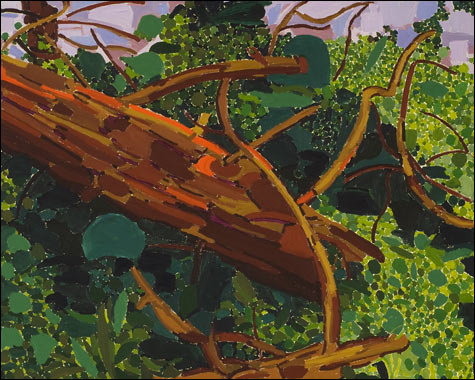
‘FELLED TREE’ Oil on canvas, 32 1/16 by 40 inches, by Lynne Drexler, 1981. |
Lynne Drexler's artistic path can not have been an easy one. Drexler, who was living on Monhegan Island when she died in 1999, had been part of the second generation of American abstract painters in the late 1950s along with, among others, Robert Goodnough, Joan Mitchell, Grace Hartigan, and her husband, John Hultberg.
The Portland Museum of Art, in cooperation with the Monhegan Museum, has mounted a sizeable retrospective exhibition of Drexler's work, providing a detailed look at nearly four decades of her career.
Drexler studied with the two most thoughtful theorists of American abstraction: Hans Hoffmann, from whom she learned about color interactions, and Robert Motherwell, who could articulate better than any other artist the existential foundation of abstract painting.
Living with Hultberg meant a somewhat peripatetic existence, from New York to Monhegan and back to the city and off to other places, but Monhegan became a constant in Drexler's life, and she lived there full-time from 1983 until her death. As Hultberg moved toward his characteristic gloomy, high-tension fractured representation, Drexler's paintings became looser and more colorful.
By the early 1960s Drexler had arrived at a coherent non-objective organization for her paintings, but even in the most abstract works, references to something observed remain. The large painting "Fog in the Meadow" from 1962, for instance, is made up of layers of discrete local splotches of color, but the dominant color is a fog-like blue gray punctuated by little splotches of yellow and green, the colors one would see in a foggy field.
She seemed most confident about the enterprise of abstraction while thinking about music. Drexler loved the opera, particularly the deep melodramas of Wagner, Richard Strauss, Mahler, and Mussorgsky. The 1974 painting "Blue Windows" is said to have been painted while listening to Beethoven, and while it has the colors of the darkening sky, its short, deliberate strokes are laid on with a rhythmic pattern set in a structure that suggests a complex chord progression.
There's a sense of unease that runs through this show, taken all together. It feels as if Drexler was subject, at times, to a lack of confidence in her own ability. Looked at from the outside it seems that she had aptly demonstrated a sufficient grasp of the principles of her chosen artistic methods, but perhaps she would occasionally lose assurance in what she was doing. Some paintings, such as "Incandescent Meadow" from 1980 and "Abigail" from 1988, feel as if she were hunting for something by contriving a method, rather than simply relying on her own skill and experience. Perhaps there were times when the solitude of Monhegan became isolation, and concentration became obsessiveness.
Her later paintings were less abstract than the early ones and more experimental. "Begonias Begone," from 1991, is squarely in the modernist representational method, but the color choices are unusual, not to say quirky. The middle of the canvas is set in blues punctuated with pinks, while the left and bottom are anchored in yellow patterns. A brown vase of yellow and white flowers painted with a bright green background occupy the right of the painting, while green Matisse-like arabesques with red flowers, possibly the titular begonias, appear on the left. The most startling feature of the painting is the black patterned background that forms the right quarter of the background. It almost, but not quite, reads as a window with the night sky.